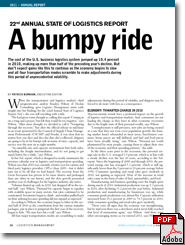2011 State of Logistics: Ocean
Carriers get their house in order
According to analysts at IHS Global Insight, the housing crisis and continued decline in residential construction is making a major impact on containerized shipping volumes.
In his latest white paper, IHS Global Insight analyst Andrei Roudoi notes that housing market indicators, such as new starts and permits last spring, were “quite unfavorable,” and there is a substantial risk that residential construction and furniture imports will under-perform.
“While falling unemployment will probably stimulate demand for housing, tighter lending regulations, as well as declining house prices combined with rising prices for construction materials, may lead to another decline in real residential construction in 2011,” says Roudoi.
Following furniture, wearing apparel and fruits and vegetables are the next two most significant containerized import categories. In 2010, wearing apparel accounted for 6.6 percent of total containerized exports, while fruits and vegetables had a 6.3 percent share.
|
|
|
|
Visit the 2011 Quest for Quatlity Winners NATIONAL LTL | REGIONAL LTL | TRUCKLOAD | RAIL | |
“The recession affected these categories less than many others, such as furniture, metal products, or motor vehicle parts,” says Roudoi. “In 2010, wearing apparel imports rose 12.5 percent, exceeding the pre-recession high.” Fruit and vegetable imports inched up 2 percent, remaining slightly below the pre-recession peak. IHS Global Insight forecasts that imports of these commodities will grow this year, 7.6 percent and 2.7 percent, respectively.
Furthermore, IHS maintains that world trade has mostly recovered from the recession. Analysts estimate that after plunging 10 percent in 2009, global trade volume (measured in tons) increased 8.5 percent in 2010. In 2011, it is expected to grow 6.9 percent.
“Thus, the volume will exceed the pre-recession level, and the recovery will be generally completed,” says Roudoi. “At the same time, volumes in some major trade segments—notably, U.S. containerized import volume—will remain below the pre-recession numbers.”
Ocean carrier executives, meanwhile, are taking nothing for granted, and the tired old cliché “thinking outside the box” takes on new meaning when invoked by the world’s leading container shipping company.
In addition, the container shipping industry may be standing on the brink of an “era-defining moment” as it faces fundamental challenges, says Maersk Line CEO, Eivind Kolding. He adds that if carriers are to secure their right to operate in the future, the industry needs to change now.
He notes that containerization—often referred to as the engine of globalization—revolutionized world trade. The potential it unlocked by connecting producers and consumers across the world enabled both shipping lines and their customers to develop their businesses in ways that previously had seemed impossible.
“However, container shipping is also the story of an established business model that often disappoints customers: one in every two containers is late, shipping lines can be complex to do business with, and the industry, even while being the most environmentally-friendly transportation mode, still lacks transparency and common goals,” Kolding says.
With examples from the automotive, aviation, portable music players, and mobile phone industries, Kolding adds that just because an industry is established, it may only be a “few years from being completely overtaken” by new technology.
“Market and customer behavior is forcing companies to never lose sight of what customers really want—including the needs that they are not even aware of.”
Finally, Kolding asks: “Why not see these as fantastic opportunities? What if we could guarantee that cargo would be on time, every time? What if placing a shipping order was as easy as buying an airline ticket? What if the shipping industry was known for beating environmental expectations—not struggling to meet them?”














